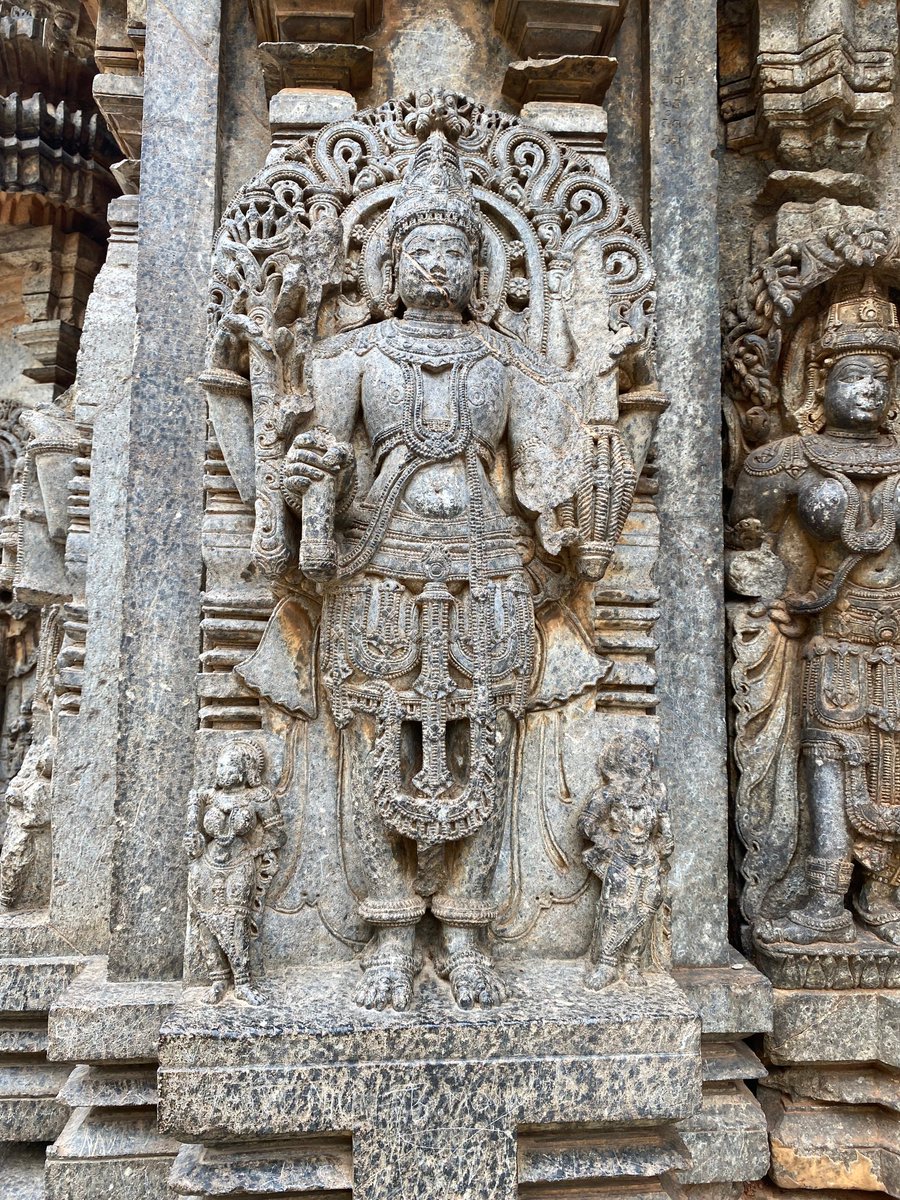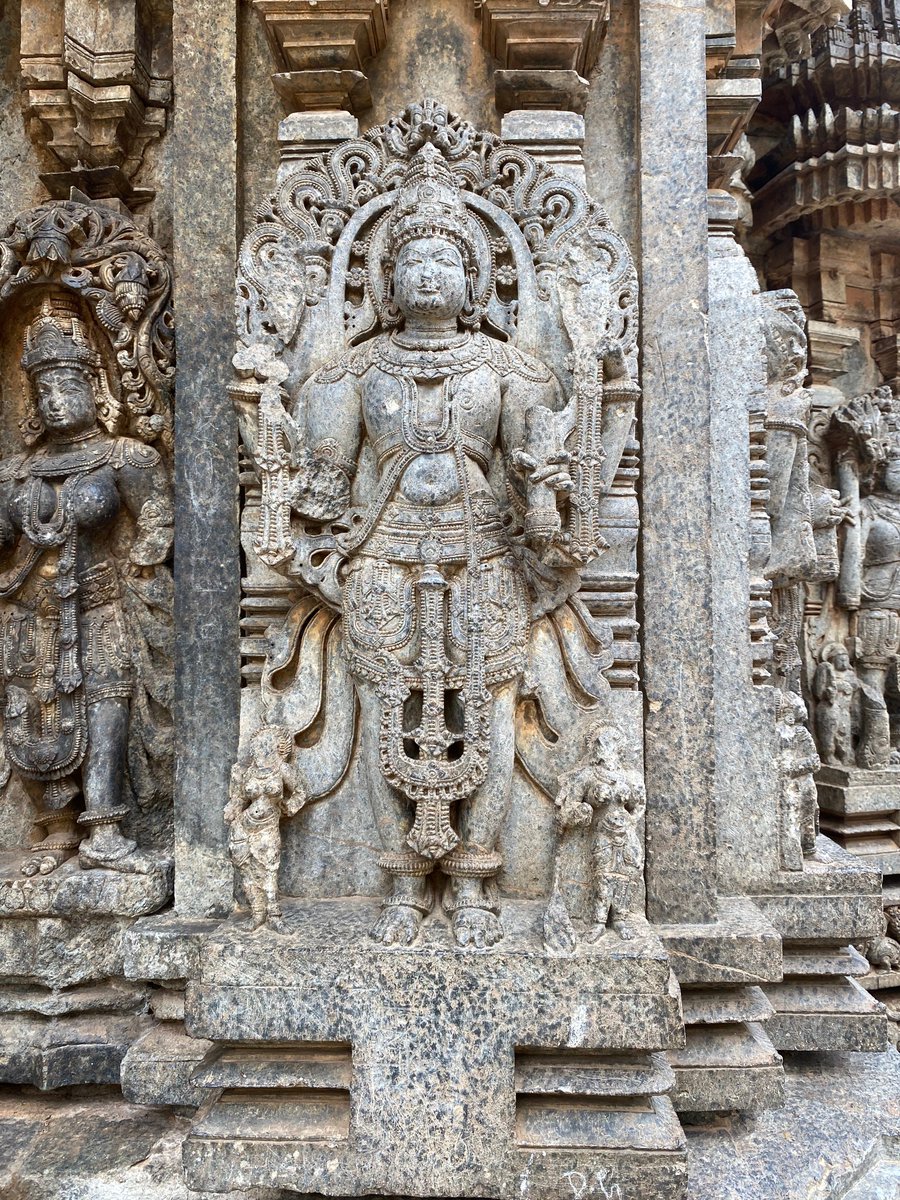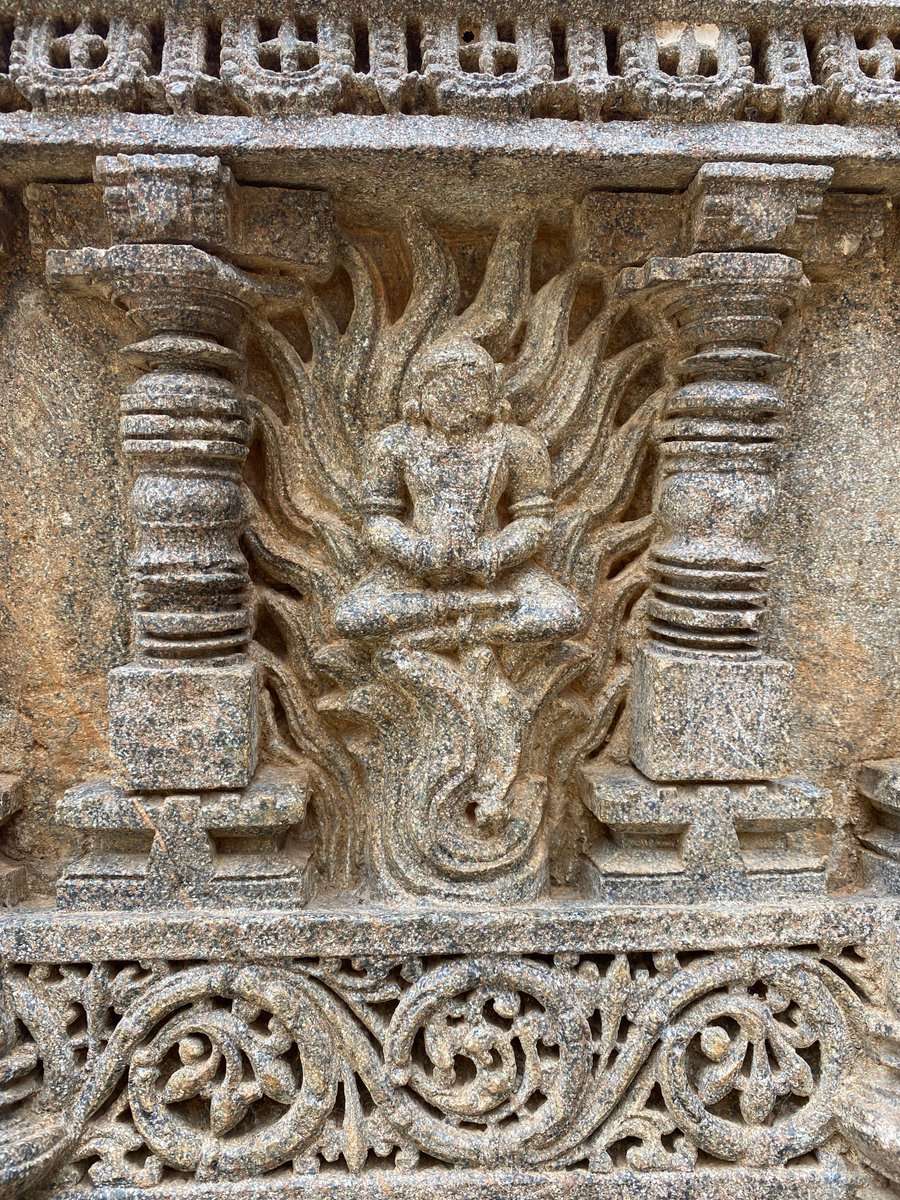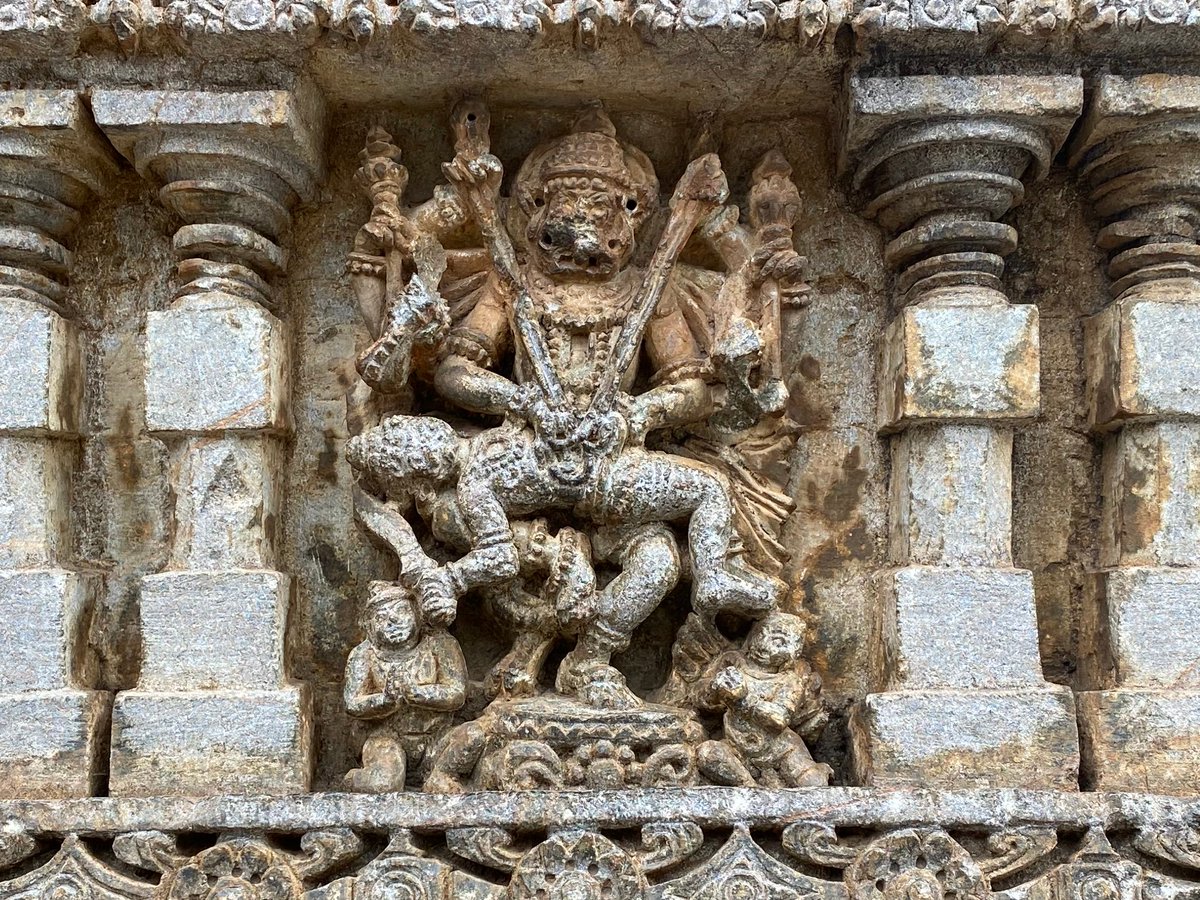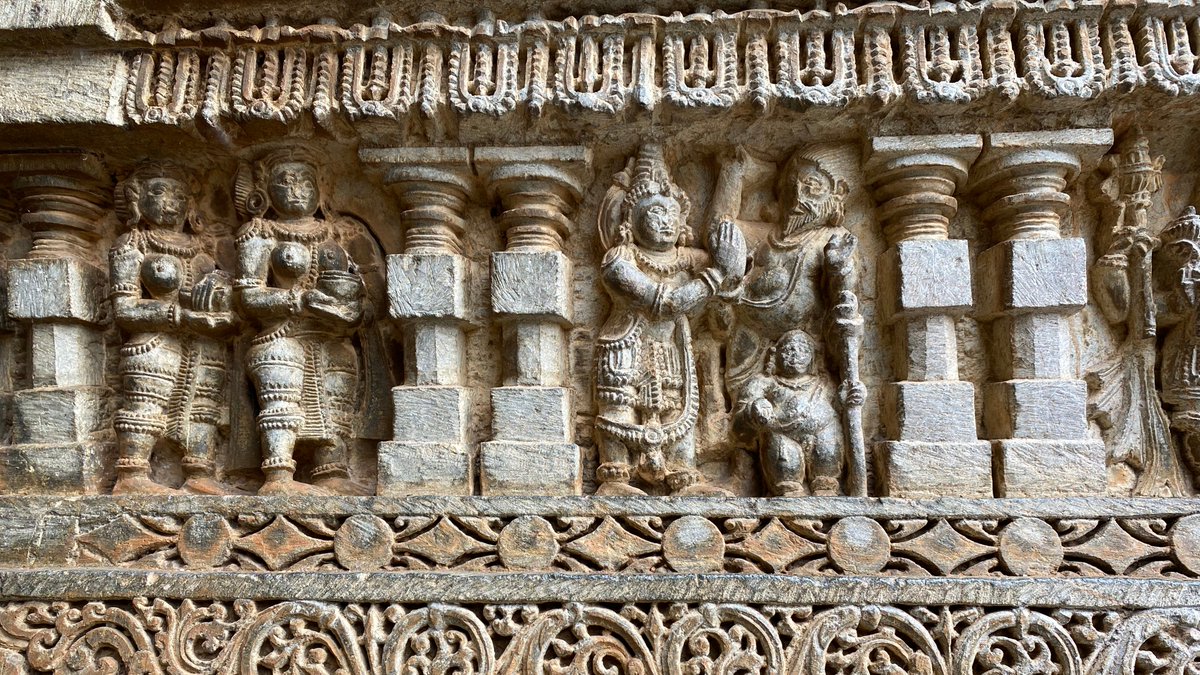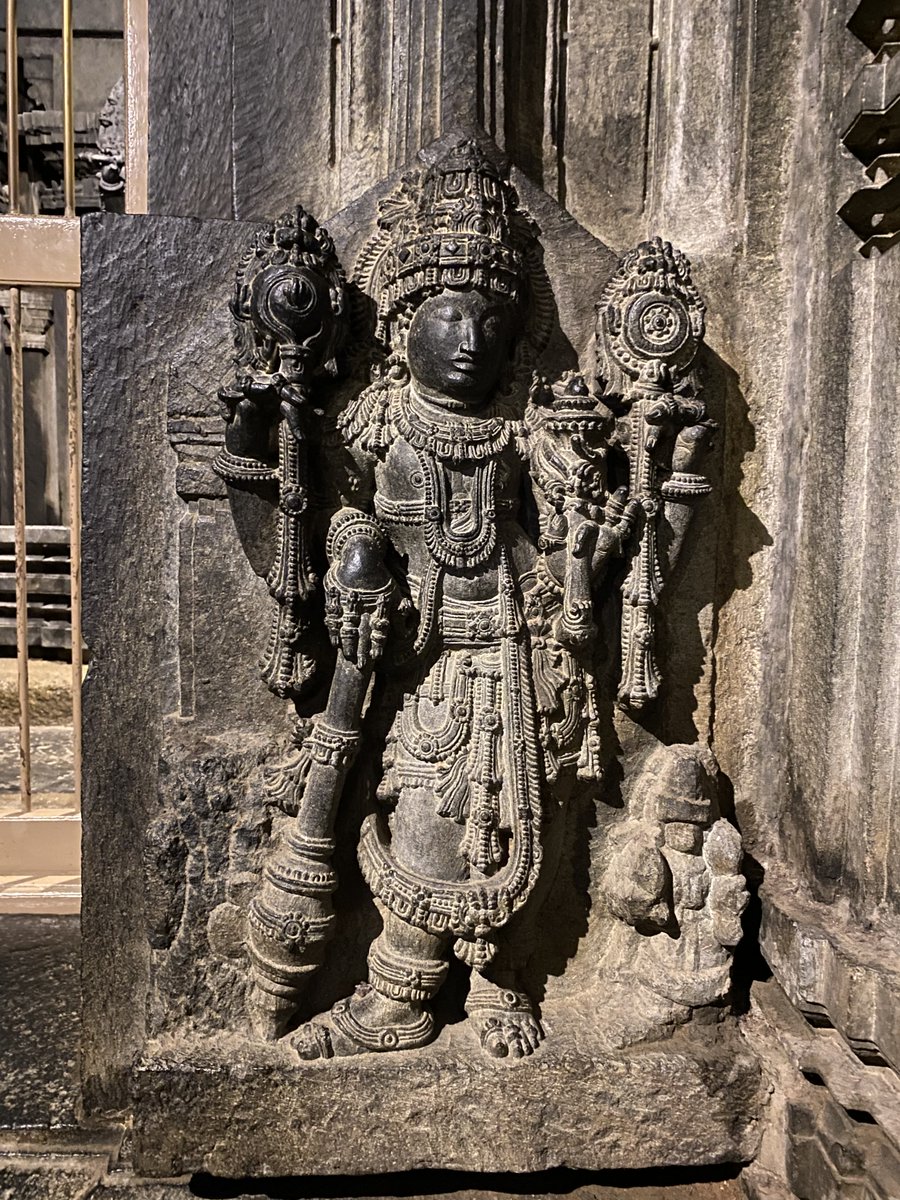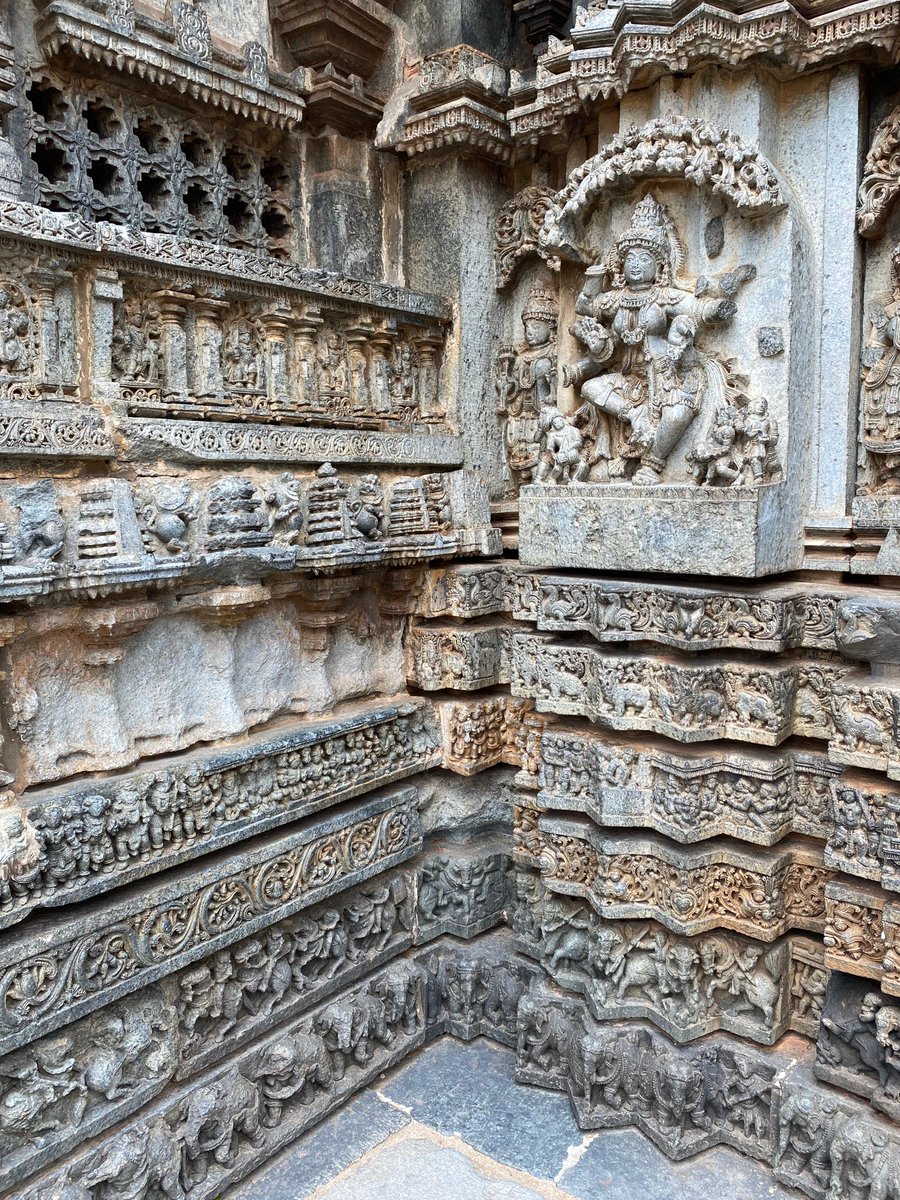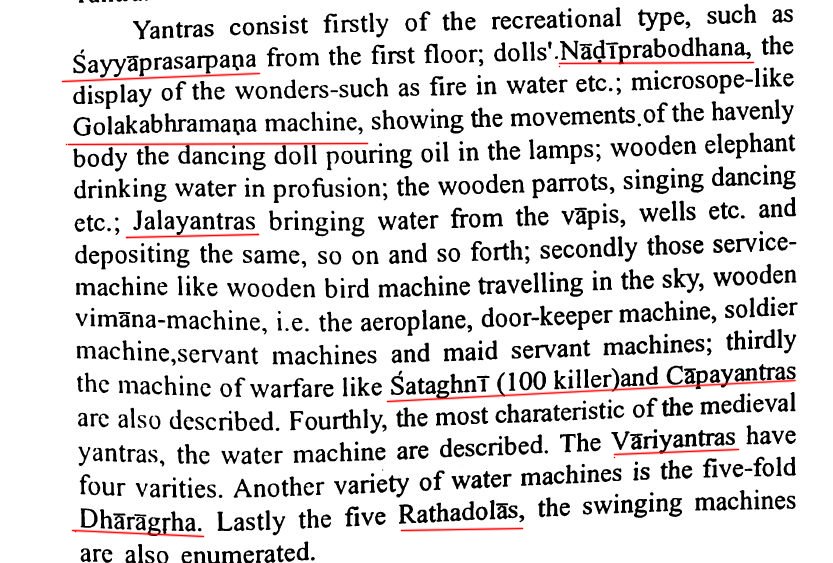A detailed THREAD on the history, architecture & sculpture of the Hoysala built Chennakeshava Temple at Somanathapura, Karnataka.
This is going to be a long one & it took me a while to piece all the information together. Do continue reading till the end. Lets's start 🕉️ (1)


This is going to be a long one & it took me a while to piece all the information together. Do continue reading till the end. Lets's start 🕉️ (1)
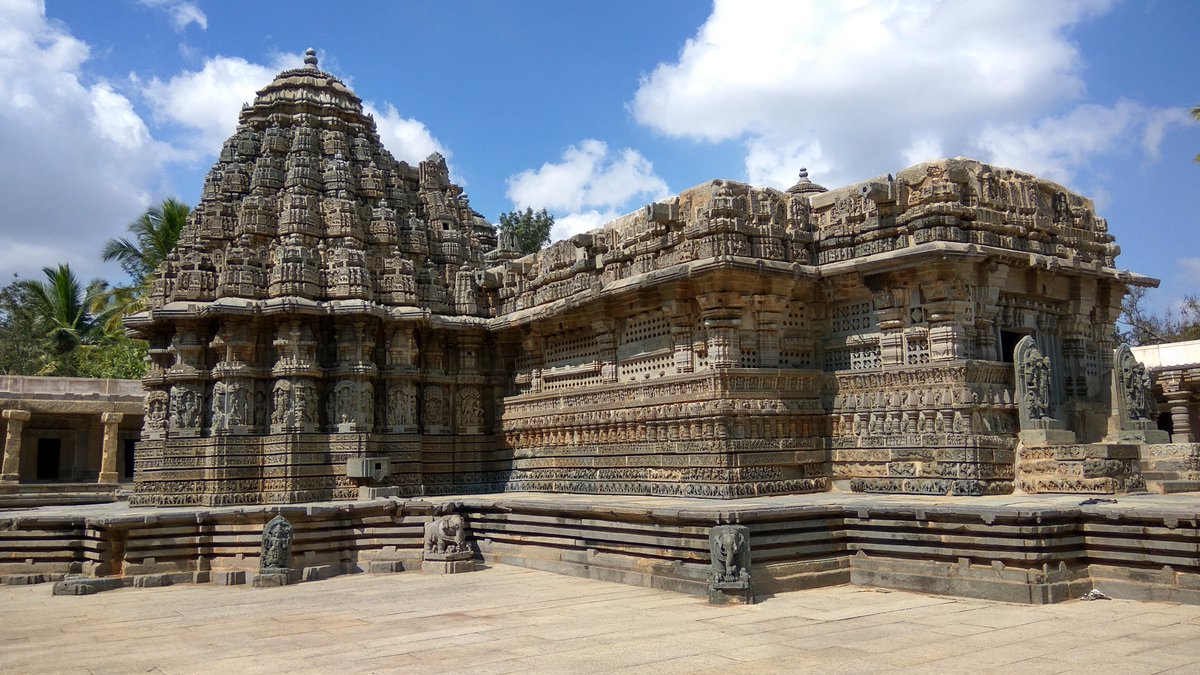

The Keshava temple was constructed by Somanatha Dandanayaka on receiving funds from reigning King Narasimha III. This temple was consecrated in 1238 CE & is considered the last major temple building activity undertaken by the Hoysalas. (2)




In front of the entrance of the temple is a 10mt high Dipasthambha. The Temple is enclosed in a prakara wall & is entered through a mantapa on the east. To the left of this mantapa is a 3mt high slab with inscription in both Kannada & Sanskrit dating to the reign of Narasimha (3)




The 1st inscription has 91 lines & is in old Kannada script in both Kannada & Sanskrit. It registers a gift of 3000 pieces of gold by king Narasimha for the worship of Keshava.
The next 3 inscriptions are all in Kannada & relates to land grants, temple revenue etc (4)
The next 3 inscriptions are all in Kannada & relates to land grants, temple revenue etc (4)

The Keshava temple is regarded as one of the most perfectly designed Trikutachala (triple celled) temple. The main temple stands on a Jagati (Platform) and follows a stellate (star shaped) floor plan.
I have labelled the different architectural elements of the temple (5)
I have labelled the different architectural elements of the temple (5)

1) Jagati
The Jagati at around 3 ft in height serves as the Pradishhana patha. As one walks in a clockwise manner, we can pictorially read stories from Ramayana, Mahabharata & Bhagavata Purana. We will look at these carvings in detail later. (6)
The Jagati at around 3 ft in height serves as the Pradishhana patha. As one walks in a clockwise manner, we can pictorially read stories from Ramayana, Mahabharata & Bhagavata Purana. We will look at these carvings in detail later. (6)

2) Adhisthana (Plinth)
Here we can see 6 tiered frieze(Kapota-bandha) beginning from the lowest, a row of elephants. Then cavalry with horsemen. Followed by foliated creepers. This followed by scenes from Purana-Itihasa. Followed by friezes of Makara & Hamsa (7)
Here we can see 6 tiered frieze(Kapota-bandha) beginning from the lowest, a row of elephants. Then cavalry with horsemen. Followed by foliated creepers. This followed by scenes from Purana-Itihasa. Followed by friezes of Makara & Hamsa (7)

3) Bhitti
The wall portion of temple is known as Bhitti. The Bhitti has sculptures of Devatas, Gandharvas, Rishis etc. There are nearly 200 sculptures on the Bhitti, all of which will be thoroughly examined in this thread. It includes Chaturvimsati Vishnu(24 forms of Vishnu) (8)
The wall portion of temple is known as Bhitti. The Bhitti has sculptures of Devatas, Gandharvas, Rishis etc. There are nearly 200 sculptures on the Bhitti, all of which will be thoroughly examined in this thread. It includes Chaturvimsati Vishnu(24 forms of Vishnu) (8)

4) Kakshasana
The last course of the Adhistana support the Kakshasana of the porch balcony seating. The sloping external surface of the Kakshasana is decorated with stories from the Puranas including that of Bhakta Prahalada. We'll explore these carvings later. (9)
The last course of the Adhistana support the Kakshasana of the porch balcony seating. The sloping external surface of the Kakshasana is decorated with stories from the Puranas including that of Bhakta Prahalada. We'll explore these carvings later. (9)

5) Jalandhrakas (jali) Above the Kakshasana, decorative stone screens (jalandhrakas) enclose the mantapa inside which allow diffused light into the inner spaces. The decorative patterns were added during the time of Veera Ballala III. There are 20 such windows in total. (10)




6) Chadya
The Chadya that runs along the entire Temple acts as a separation layer between the Bhitti & the main Shikhara. The Chadya features numerous miniature Shikharas positioned just above the Bhitti sculptures . (11)
The Chadya that runs along the entire Temple acts as a separation layer between the Bhitti & the main Shikhara. The Chadya features numerous miniature Shikharas positioned just above the Bhitti sculptures . (11)

7) Shikhara
Each of the 3 Shikharas of the temple is elaborately but very similarly designed. Each is built in the plan of a 16 pointed star. There are carvings of Simhamukhas, Kirtimukhas, Makaras, Yakshas, Gandharavas. (12)

Each of the 3 Shikharas of the temple is elaborately but very similarly designed. Each is built in the plan of a 16 pointed star. There are carvings of Simhamukhas, Kirtimukhas, Makaras, Yakshas, Gandharavas. (12)


Now lets have a look at the exquisite wall sculptures. There are around 200 murthis. We'll attempt to identify them all. Some of the sculptures also bear names of the Sthapatis who sculpted them. Some them include Mallitamma, Cahudiah, Baliah, Masanitamma, Lohita, Elemasiah..(13)








Vaikuntanarayana
Vishnu is seated at ease on the coils of Ananta whose 7 hoods are seen above. Vishnu holds Shanka & Chakra & has a hand resting on the seat & the other hand loosely placed on the knee. Devatas & rishis pay obeisance to him (14)
Vishnu is seated at ease on the coils of Ananta whose 7 hoods are seen above. Vishnu holds Shanka & Chakra & has a hand resting on the seat & the other hand loosely placed on the knee. Devatas & rishis pay obeisance to him (14)

Tandava Ganapathi
Ganesha dancing. He is seen holding an ankusha, svargahasta, padma, apuupa bowl. There is a Apsara playing the Dhavane (percussion) on his left. (15)
Ganesha dancing. He is seen holding an ankusha, svargahasta, padma, apuupa bowl. There is a Apsara playing the Dhavane (percussion) on his left. (15)

Nritya Sharadha/Saraswati
She is seen holding in her 8 hands the Veena, lambahasta, ankusha, akshamala, svargahasta(broken), pustaka. She is accompanied by percussionists. The sculptor who created this masterpiece has left his signature below & is identified as Nanjiah. (16)
She is seen holding in her 8 hands the Veena, lambahasta, ankusha, akshamala, svargahasta(broken), pustaka. She is accompanied by percussionists. The sculptor who created this masterpiece has left his signature below & is identified as Nanjiah. (16)

Janardhana
This is one of the 24 forms of Vishnu. He holds an Akshamala, Chakra,Shanka & a Phala. Also seen to the right is Lakshmi (17)
This is one of the 24 forms of Vishnu. He holds an Akshamala, Chakra,Shanka & a Phala. Also seen to the right is Lakshmi (17)

Keshava
Yet another one of the 24 forms of Vishnu. He has 6 hands, holding a gada, padma, shanka, chakra, paasa, dhana. Lakshmi is seen to the left. (18)
Yet another one of the 24 forms of Vishnu. He has 6 hands, holding a gada, padma, shanka, chakra, paasa, dhana. Lakshmi is seen to the left. (18)

Keshava
He holds Phala instead of gada. But its broken. Lakshmi is seen to the right. Baliah has been identified as the sculptor of this image. (19)
He holds Phala instead of gada. But its broken. Lakshmi is seen to the right. Baliah has been identified as the sculptor of this image. (19)

Venugopala
Gada, chakra, shanka & padma are seen near Venugopala's head. The flute is partially damaged. Gopikas can be seen dancing. Cows are also seen. Near his feet a serpent is also seen. Chamaiah is identified as the sculptor of this murthi. (20)
Gada, chakra, shanka & padma are seen near Venugopala's head. The flute is partially damaged. Gopikas can be seen dancing. Cows are also seen. Near his feet a serpent is also seen. Chamaiah is identified as the sculptor of this murthi. (20)

Indra
He is standing in samabhanga & has 4 objects bearing in each hand. Shanka & Chhakra in the upper hand. Vajra & Danda in his lower hands. (22)
He is standing in samabhanga & has 4 objects bearing in each hand. Shanka & Chhakra in the upper hand. Vajra & Danda in his lower hands. (22)

Rama
Vishnu as Rama with 6 hands, holding arrow, chakra, padma, shanka, gada & a patra. The maker of this image is identified as Bomma (23)
Vishnu as Rama with 6 hands, holding arrow, chakra, padma, shanka, gada & a patra. The maker of this image is identified as Bomma (23)

Prasanna Raghava
Vishnu with 6 hands. Seen holding Abhaya mudra, shanka, arrow, bow, padma & dhanus (24)
Vishnu with 6 hands. Seen holding Abhaya mudra, shanka, arrow, bow, padma & dhanus (24)

Varuna
Vasudeva as Varuna with 6 hands each holding padma, chakra, ankusha, paasa, shanka, phala. The pitha below has the inscription "Sa ni raa ra".
(25)
Vasudeva as Varuna with 6 hands each holding padma, chakra, ankusha, paasa, shanka, phala. The pitha below has the inscription "Sa ni raa ra".
(25)

Yoganarayana/Badrinarayana
He is seated in Padmasana, his back hands holding Shanka & chakra. Front hands are in yogamudra.
(26)
He is seated in Padmasana, his back hands holding Shanka & chakra. Front hands are in yogamudra.
(26)

Nritya Lakshmi
Seen on either sides of the dancing Lakshmi are Gandharavas playing the Dhavane (percussion). She has 6 hands. Each holding phala, chakra, svargahasta, shanka, lambahasta, padma.
The maker of this murthi has been identified as Mallitamma. (27)
Seen on either sides of the dancing Lakshmi are Gandharavas playing the Dhavane (percussion). She has 6 hands. Each holding phala, chakra, svargahasta, shanka, lambahasta, padma.
The maker of this murthi has been identified as Mallitamma. (27)

Sankarshana
Sankarshana is identified most commonly with Balarama. He is also called Halayudha as he wields the plough as seen in this picture. He has 6 hands in each of which he holds chakra, spear, plough, paasa, shanka & shield. The sculptor of this image is Baliah.
(28)
Sankarshana is identified most commonly with Balarama. He is also called Halayudha as he wields the plough as seen in this picture. He has 6 hands in each of which he holds chakra, spear, plough, paasa, shanka & shield. The sculptor of this image is Baliah.
(28)

Shridhara
Wields chakra, gada, shanka & padma in each one of the 4 hands. Related to 24 forms of Vishnu. Sculptor of this murthi is Mallitamma.
(29)
Wields chakra, gada, shanka & padma in each one of the 4 hands. Related to 24 forms of Vishnu. Sculptor of this murthi is Mallitamma.
(29)

Brahma
The 4 faced, 4 armed Brahma is standing in Samabhanga. He holds akshamala, shruksruva (spoon) with boar face in his right hands and pasha (noose), kaladanda (staff of death) and kalasha (pot) in his left hands. He is flanked by chamaradharinis (chauri bearers).
(30)
The 4 faced, 4 armed Brahma is standing in Samabhanga. He holds akshamala, shruksruva (spoon) with boar face in his right hands and pasha (noose), kaladanda (staff of death) and kalasha (pot) in his left hands. He is flanked by chamaradharinis (chauri bearers).
(30)

Vishnu
Standing with abhaya, chakra, shanka, dana.
(31)
Standing with abhaya, chakra, shanka, dana.
(31)
https://twitter.com/_ugra_/status/1694254364997939665/photo/1

Matsya avatara of Vishnu
Vishnu with the face of a fish standing with 6 hands out of which one is broken. The rest hold Shanka, padma, gada, chakra & maala. (34)
Vishnu with the face of a fish standing with 6 hands out of which one is broken. The rest hold Shanka, padma, gada, chakra & maala. (34)

Varaha
Vishnu with the face of a boar. Has 6 hands, each holding chatri (umbrella), chakra, shanka, padma & phala (broken)
(35)
Vishnu with the face of a boar. Has 6 hands, each holding chatri (umbrella), chakra, shanka, padma & phala (broken)
(35)

Kurmavatara
Vishnu with the face of a tortoise. Highly damaged. Back hands hold chakra & shanka. Front hands hold what is believed to be the Mandara parvata. (36)
Vishnu with the face of a tortoise. Highly damaged. Back hands hold chakra & shanka. Front hands hold what is believed to be the Mandara parvata. (36)

Parijata-apaharana
Indra & Sachi seated on the Airavata elephant defending against Krishna & Satyabhama (next image) in order to prevent the latter from carrying away the Parijata tree. (37)
Indra & Sachi seated on the Airavata elephant defending against Krishna & Satyabhama (next image) in order to prevent the latter from carrying away the Parijata tree. (37)

Lakshmi Narasimha
Narasimha seated in sukhasana with Lakshmi sitting on his lap. Prahalada is also seen to his right with folded hands. (39)
Narasimha seated in sukhasana with Lakshmi sitting on his lap. Prahalada is also seen to his right with folded hands. (39)

Vishnu
Difficult to identify which form of Vishnu this is as all the arms are broken. The stapathi who made this is Vitthala. (40)
Difficult to identify which form of Vishnu this is as all the arms are broken. The stapathi who made this is Vitthala. (40)

Vishnu
Standing with one hand in Daana. The other 3 are broken. Lohita is the sculptor of this image. (41)
Standing with one hand in Daana. The other 3 are broken. Lohita is the sculptor of this image. (41)

Nritya Sharadha
Saraswathi with 6 arms in dancing posture. Each holding Veena, ankusha, akshamala, pustaka, paasha. Sculptor has been identified as Talamasayya.
(42)
Saraswathi with 6 arms in dancing posture. Each holding Veena, ankusha, akshamala, pustaka, paasha. Sculptor has been identified as Talamasayya.
(42)

Madhava
4 armed. Each holding musala, chakra, shanka & padma. An inscription in nagari script can be seen on the pedestal. (60)
4 armed. Each holding musala, chakra, shanka & padma. An inscription in nagari script can be seen on the pedestal. (60)

The Mahabharata panels conclude with this particular panel showing the victorious Pandavas in a seated posture under a canopy. (187) 

As seen in the picture, there are 6 layers of carvings around the temple in this order:
1) Elephant
2) Horse
3) Floral
4) Carvings from Bhagavata, Ramayana & Mahabharata
5) Small sculptures of various deities including 24 forms of Vishnu
6) Railing carvings of Prahlada (188)
1) Elephant
2) Horse
3) Floral
4) Carvings from Bhagavata, Ramayana & Mahabharata
5) Small sculptures of various deities including 24 forms of Vishnu
6) Railing carvings of Prahlada (188)

Panels showing Prahlada subjected to torture by soldiers on the instructions of Hiranyakashipu (189)




Lets have a look at the temple interior. The temple has 3 cells each housing a murthi of Venugopala ,Keshava & Janardhana. (198)
The south garbhagriha houses a murthi of Venugopala. The doorway leading to south sukhanasi has a lintel featuring a carving of Venugopala. Above this is a carving of Lakshminarayana seated in suksana. (199)




The uttaranga portion of the garbhagriha doorway features a carving of a dancing form of Vishnu. (201)


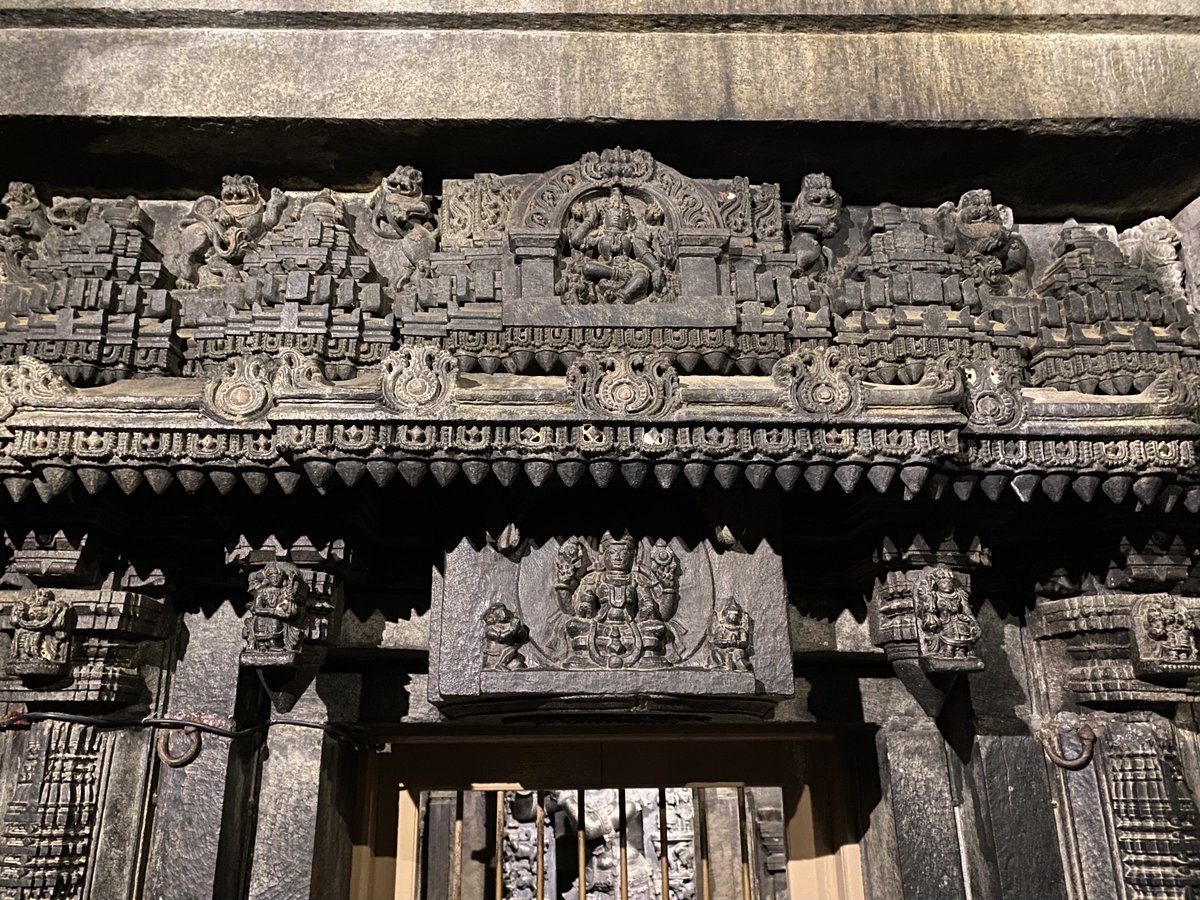

Inside the garbhagriha stands this magnificent murthi of Venugopala. The height of the murthi including the pedestal must be around 7 feet. Here Krishna is represented as being fully ornamented. He stands crossing his legs and leans against a tamala tree (202) 

The torana features various carvings including that of these cows, who have lifted their heads up & intently listing to Krishna playing the flute (202) 

The torana has carvings of various rishis. Near its edges are carved the 10 avataras of Vishnu. (203) 

The doorway leading to the west sukanasi has a lintel featuring a carving of a standing image of Keshava. Above this a carving of Gaja Lakshmi (204)


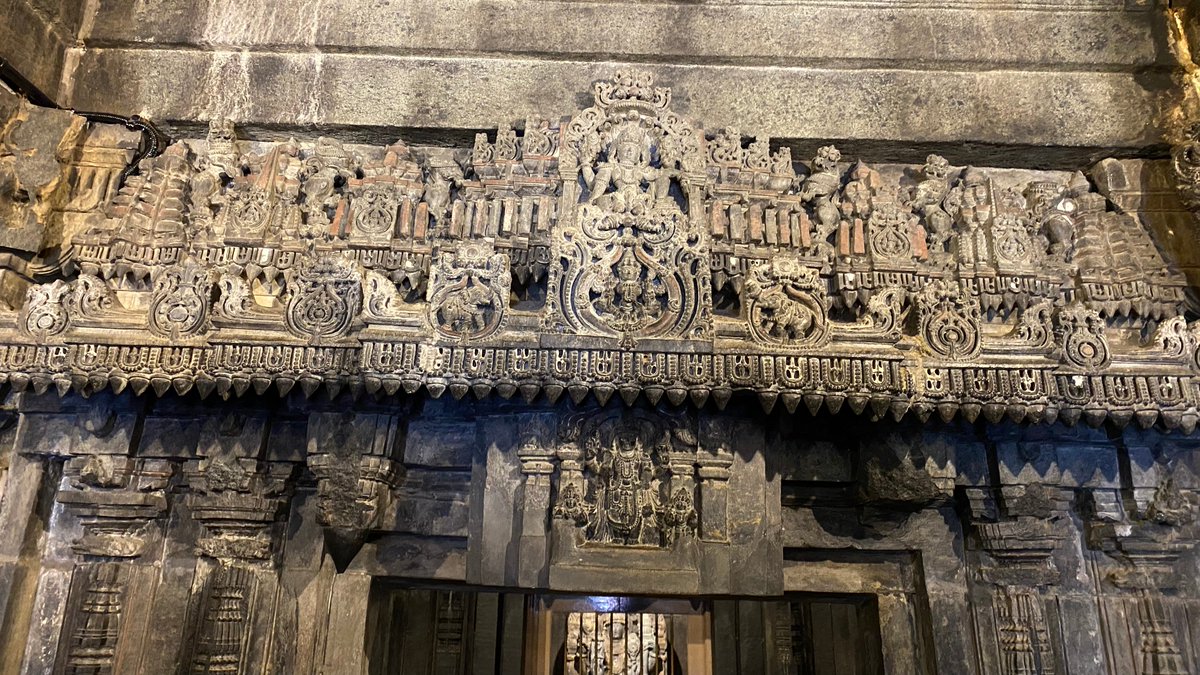

West garbhagriha doorway. On the lintel is an image of Lakshminarayana. Above this is an image of Vishnu seated in sukasana (206) 

Inside the garbhagriha is this replacement murthi of Keshava. In each of his 4 arms, he holds a Shanka Gada, Chakra & Pushpa. This is actually not the original murthi which was probably destroyed or smuggled away. (207) 

This is the doorway of the north sukanasi. On its lintel is an image of Janardhana. Above this is an image of Lakshmi-Narasimha (209) 

The north garbhagriha doorway. It features images of a seated Lakshmi holding akshamala, chakra, shanka & kalasa. Above this is an image of Yoganarayana seated in yogasana posture (211) 
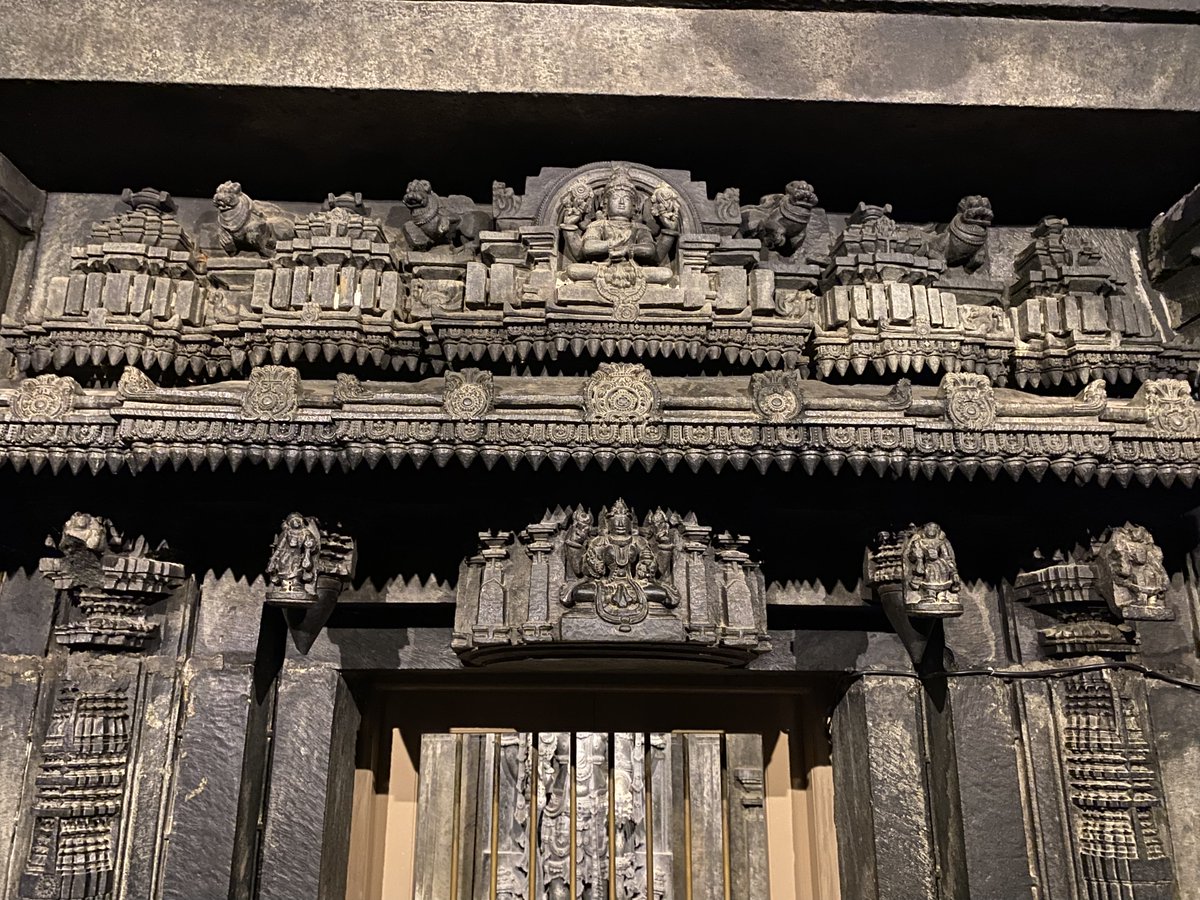
The garbagriha houses this brilliant image of Janardhana. Each of his 4 arms holds a chakra, shanka, gada & pushpa. He is flanked on either side by ayudhapurushas. The torana also features the dashavatara. (212) 

This smaller gudi in the rangamantapa originally housed a murthi of Ganesha. A miniature carving of Ganesha can be seen on the Lalatabimba. The ASI has now placed a murthi of Lakshminarayana inside the gudi. The original Ganesha was either destroyed or smuggled away (217) 

South, West & North Vimanas respectively. They are all built in the plan of a 16 pointed star in the shape of a lotus. On top of the Shikhara is a heavy round kalasa. Some of the carvings seen on the Vimanas are that of simhamukha, kirtimuka, makara, yaksha, gandharva etc (220)






Finally concluding this thread after 10 months and 225 tweets. Hope those of you who read this thread found it useful. Do share this information with your friends & followers. Thank you all for reading. Your feedback is welcome. 🙂
/end
/end

• • •
Missing some Tweet in this thread? You can try to
force a refresh




















